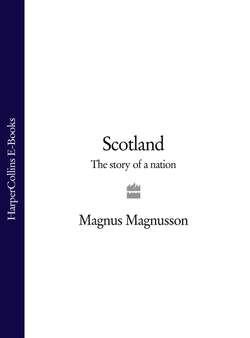Читать книгу Scotland: The Story of a Nation - Magnus Magnusson - Страница 14
The Broch of Mousa
ОглавлениеRound about 2000 BC the advent of the Bronze Age brought another revolutionary social change to Scotland with the introduction of metallurgy. A new metal, bronze, which was tougher than silver or gold or copper, underpinned the development of sophisticated social hierarchies based on wealth and power. Bronze brought about an increase in trade and an increase in the effectiveness of weaponry; and the new weaponry enabled ambitious leaders to indulge in territorial aggression.
It was now that Scotland made another uniquely Scottish contribution to architecture – the brochs. They were magnificent edifices: tall round towers, with tapering double-skinned dry-stone walls bonded together at intervals by rows of flat slabs. Between the double walls were stairs leading to galleries and small rooms on separate storeys. There was room for livestock at ground level, which had only one small, low and easily defended entrance. There were no windows. The brochs were practically impregnable.
There are some five hundred brochs, or traces of brochs, still surviving in Scotland. They were built in large numbers in the north, especially in the Northern Isles, the Western Isles and Caithness, with occasional examples in the southern part of the country.
When were they built, and why? They seem to have originated in Orkney early in the Iron Age, around 200 BC, and were being built until about AD 200, when they were more or less abandoned; their stones were robbed for newer buildings in the farming communities which had been growing around them. They can only have been built as powerful symbols of local authority and prestige, which could also act as strongholds for the local people in times of danger: part refuge, part status symbol.
And who built them? They used to be called ‘Pictish towers’, but in fact they were constructed by the ancestors of the Picts – the indigenous inhabitants of northern and western Scotland from whom the historical Picts were descended (see Chapter 3).
My own favourite is a broch which stands on a tiny uninhabited island off the east coast of Shetland – the broch of Mousa. It is the best-preserved of all Scotland’s brochs; it is still almost intact, standing to a height of thirteen metres. Many centuries after it ceased to be used by the local population the Icelandic sagas record that it was used on two occasions as a refuge by runaway lovers in viking times.
Egil’s Saga relates how, around AD 900, an Icelander in Norway fell in love with the sister of a powerful Norwegian war-chief, Thórir Hróaldsson, named Thóra Hlaðhönd (Lace-Cuff); her suitor was Björn Brynjólfsson. Thórir refused permission for them to marry, whereupon the lovers eloped one night and boarded a ship bound for Iceland, but were shipwrecked on Shetland on the way. They spent a secure and comparatively comfortable honeymoon that winter in the broch of Mousa while their ship was being repaired, and in the spring they completed their journey to Iceland and lived happily ever after. The daughter of that marriage, Ásgerð, who was conceived on Mousa, became the wife of the eponymous hero of the saga, the great viking warrior-poet Egil Skallagrímsson.
Orkneyinga Saga (‘The Saga of the Earls of Orkney’) tells how, in 1153, a high-born lady named Margaret, the mother of Earl Harald of Orkney, was abducted by an ardent admirer named Sigurður. The couple holed up with a band of supporters in the broch of Mousa. They had brought in plentiful supplies of food and water, and Earl Harald wrathfully but vainly besieged the broch all winter. Eventually he was forced to agree to the marriage.
These stories seem to me to underline the constant need for security in a world which was becoming more and more violent and aggressive. Safety was paramount – and the more prosperous you were, the more important safety precautions became.
